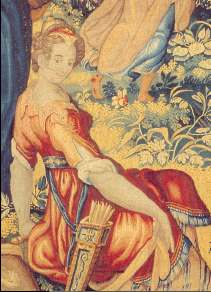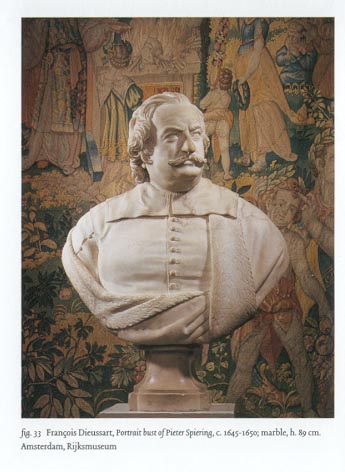FS
 Francois
Spiering / Spierincx (c.1576?-1630?). From Antwerp. He arrived in Delft 1591,
became member of the Guild in 1613. In his successful tapestry
workshop he produced figurative (pictorial) tapestries. He was
visited in 1598 by the diarist Aernout van Buchell (1565?-1641) who
in his diary raved about the pictorial quality and colour which was -
he wrote - nearly as good as that of oil paints.
Francois
Spiering / Spierincx (c.1576?-1630?). From Antwerp. He arrived in Delft 1591,
became member of the Guild in 1613. In his successful tapestry
workshop he produced figurative (pictorial) tapestries. He was
visited in 1598 by the diarist Aernout van Buchell (1565?-1641) who
in his diary raved about the pictorial quality and colour which was -
he wrote - nearly as good as that of oil paints.
To the right: Wall tapestry in the Rijksmuseum, Amsterdam, 345 x
520 cm. from the François Spiering workshop: 'Cephalus and
Procris' from Ovid, Metamorphoses, on the subject of
marital fidelity. Below a detail showing the 'painterly' quality of
the depiction.
From 1592 onwards Spiering's workshop was located at St Agnes
convent or Agnietenklooster - alias Spierinxklooster- at the last
block of houses of Oosteinde, south side, near East gate. This
building measured 6 by 8 meters, having bare walls. It was given to
him free of rent as the Town of Delft valued his workshop activities.
From 1599 onwards he rented a yard connected to the St Agnes convent.
He employed, each for a certain time, the painters/designers
H.C. Vroom and Karel
van Mander the elder.
Karel van Mander the Younger had
started out as a gifted tapestry designer in Spiering's workshop, and
he founded his own workshop later on, aggressively hijacking an order
of 24 tapestries which were originally to be executed by
Spiering.
In 1613 the States General contracted him to produce a series of
grand tapestries for the sum of 16.933 guilders. On May 17, 1616 Van
Mander rented a house belonging to the St Anna convent for this
purpouse.
Spiering owned an art collection which boasted fine prints and
drawings including works from Italy and a superb collection of Lucas
van Leyden. This collection was transfered by his sons to The Hague
in 1638.
His son and inheritor was Pieter Spiering (c 1594/7-1652), nicknamed Silvercroon,being charge d'affaits in Sweden, becoming Lord of Norsholm. Moved his art collection to The Hague in 1638. Consorted with artists such as Torrentius, Dou, Sandrart. Bought1641 from teh latter art books filled with Italian drawings gather during his Italian trip, at the cost of F 3500. Also became art buying agent for queen Christina of Sweden. He continued his father's company together with is brother Aert Spiering (1593-1650)
Francois Spiering's workshop was continued by his sons Aert
Spiering (1593-1650) and Pieter
Spiering.
See also Van der Gucht's workshop.
 Note.
RKD, Bredius archive, artist folder. Arrived in Delft 1591 (not 1600
as is stated elsewhere). On 13 Aug 1612 he is 36 years old, thus was
born c. 1576. Ysselsteyn, vol. 1 (1936) 67, e.v. The 1613 contract in
Soutendam Necrologium, p. 16-17. Mentioned by Jaap van der
Veen in 'De Delftse kunstmarkt in de tijd van Vermeer" in De
Hollandse Samenleving in de tijd van Vermeer, Zwolle/The Hague
1996, note 35, p. 135. Vital years 1549/51-1631 with ? provided by
researcher Jaap van der Veen, private communication 2001. Van Buchell
reports a "vierkante el" (square foot) cost 26 guilders, see
Houtzager, Delfia Batavorum 1993, p. 54. Details on the
convent in H.C. Brouwer, 'Stedebouwkundige veranderingen...' in
exh.cat. De Stad Delft, cultuur en maatschappij van 1572-1667, Vol I,
p. 37. Museum Prinsenhof Delft, 1981. See exh. cat. Metropolitan
Museum of Art, 'Vermeer and the Delft School', page 40. Exh
Cat 'Schatten in Delft', Prinsenhof, Delft 2002, p.156.
Note.
RKD, Bredius archive, artist folder. Arrived in Delft 1591 (not 1600
as is stated elsewhere). On 13 Aug 1612 he is 36 years old, thus was
born c. 1576. Ysselsteyn, vol. 1 (1936) 67, e.v. The 1613 contract in
Soutendam Necrologium, p. 16-17. Mentioned by Jaap van der
Veen in 'De Delftse kunstmarkt in de tijd van Vermeer" in De
Hollandse Samenleving in de tijd van Vermeer, Zwolle/The Hague
1996, note 35, p. 135. Vital years 1549/51-1631 with ? provided by
researcher Jaap van der Veen, private communication 2001. Van Buchell
reports a "vierkante el" (square foot) cost 26 guilders, see
Houtzager, Delfia Batavorum 1993, p. 54. Details on the
convent in H.C. Brouwer, 'Stedebouwkundige veranderingen...' in
exh.cat. De Stad Delft, cultuur en maatschappij van 1572-1667, Vol I,
p. 37. Museum Prinsenhof Delft, 1981. See exh. cat. Metropolitan
Museum of Art, 'Vermeer and the Delft School', page 40. Exh
Cat 'Schatten in Delft', Prinsenhof, Delft 2002, p.156.
This page forms part of a large encyclopedic site on Delft. Research by Drs. Kees Kaldenbach (email). A
full presentation is on view at johannesvermeer.info.
Launched 16 February 2005; Source: Schatten in Delft, exh. cat. museum Prinsenhof, 2002, p. 156.
Last update 22 february, 2018. More info in the RKD site.
 Francois
Spiering / Spierincx (c.1576?-1630?). From Antwerp. He arrived in Delft 1591,
became member of the Guild in 1613. In his successful tapestry
workshop he produced figurative (pictorial) tapestries. He was
visited in 1598 by the diarist Aernout van Buchell (1565?-1641) who
in his diary raved about the pictorial quality and colour which was -
he wrote - nearly as good as that of oil paints.
Francois
Spiering / Spierincx (c.1576?-1630?). From Antwerp. He arrived in Delft 1591,
became member of the Guild in 1613. In his successful tapestry
workshop he produced figurative (pictorial) tapestries. He was
visited in 1598 by the diarist Aernout van Buchell (1565?-1641) who
in his diary raved about the pictorial quality and colour which was -
he wrote - nearly as good as that of oil paints. Note.
RKD, Bredius archive, artist folder. Arrived in Delft 1591 (not 1600
as is stated elsewhere). On 13 Aug 1612 he is 36 years old, thus was
born c. 1576. Ysselsteyn, vol. 1 (1936) 67, e.v. The 1613 contract in
Soutendam Necrologium, p. 16-17. Mentioned by Jaap van der
Veen in 'De Delftse kunstmarkt in de tijd van Vermeer" in De
Hollandse Samenleving in de tijd van Vermeer, Zwolle/The Hague
1996, note 35, p. 135. Vital years 1549/51-1631 with ? provided by
researcher Jaap van der Veen, private communication 2001. Van Buchell
reports a "vierkante el" (square foot) cost 26 guilders, see
Houtzager, Delfia Batavorum 1993, p. 54. Details on the
convent in H.C. Brouwer, 'Stedebouwkundige veranderingen...' in
exh.cat. De Stad Delft, cultuur en maatschappij van 1572-1667, Vol I,
p. 37. Museum Prinsenhof Delft, 1981. See exh. cat. Metropolitan
Museum of Art, 'Vermeer and the Delft School', page 40. Exh
Cat 'Schatten in Delft', Prinsenhof, Delft 2002, p.156.
Note.
RKD, Bredius archive, artist folder. Arrived in Delft 1591 (not 1600
as is stated elsewhere). On 13 Aug 1612 he is 36 years old, thus was
born c. 1576. Ysselsteyn, vol. 1 (1936) 67, e.v. The 1613 contract in
Soutendam Necrologium, p. 16-17. Mentioned by Jaap van der
Veen in 'De Delftse kunstmarkt in de tijd van Vermeer" in De
Hollandse Samenleving in de tijd van Vermeer, Zwolle/The Hague
1996, note 35, p. 135. Vital years 1549/51-1631 with ? provided by
researcher Jaap van der Veen, private communication 2001. Van Buchell
reports a "vierkante el" (square foot) cost 26 guilders, see
Houtzager, Delfia Batavorum 1993, p. 54. Details on the
convent in H.C. Brouwer, 'Stedebouwkundige veranderingen...' in
exh.cat. De Stad Delft, cultuur en maatschappij van 1572-1667, Vol I,
p. 37. Museum Prinsenhof Delft, 1981. See exh. cat. Metropolitan
Museum of Art, 'Vermeer and the Delft School', page 40. Exh
Cat 'Schatten in Delft', Prinsenhof, Delft 2002, p.156.